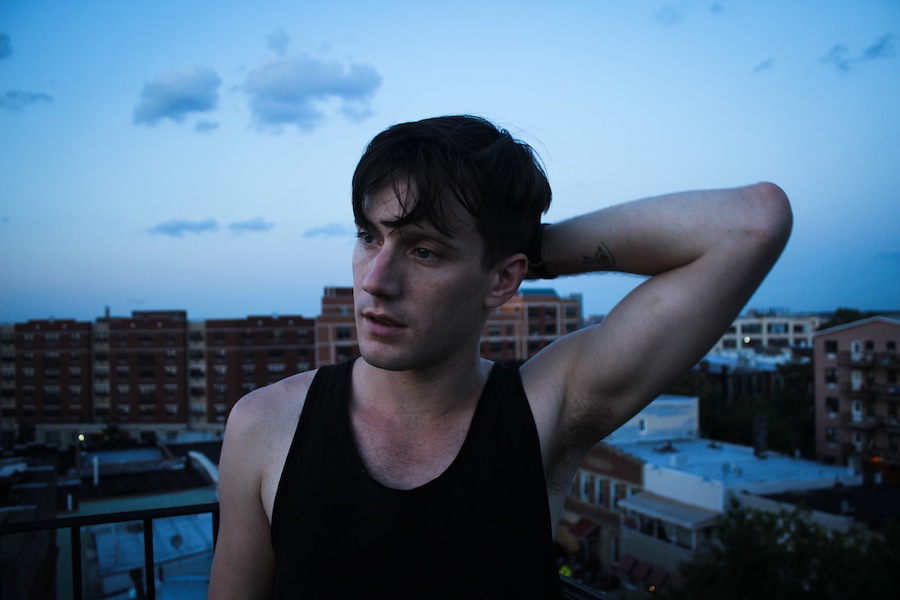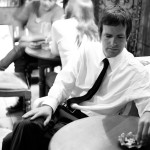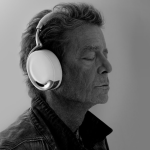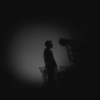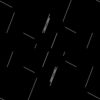“Raw and live as fuck.”
That’s how Daniel Martin-McCormick described his Ital shows the last time we talked. A simple but suitable answer really, considering how Ital fuses a lifetime of loving dance music with actually making the stuff. Before the project’s string of promising 12-inches last year, the producer/multi-instrumentalist was better known as half of Mi Ami and one of the former mad men in the Ian MacKaye-approved–and aptly named–Black Eyes.
The latest Ital LP (Dream On) arrives less than nine months since his last (Hive Mind), and reflects both his post-hardcore upbringing–in spirit, at least–and the spastic, video-scrambling nature of Ital’s current live incarnation alongside visual artist/party promoter/Innergaze co-founder Aurora Halal. The latter will be making several North American stops this month, including an Art Basel appearance in Miami this weekend. In the following interview, Martin-McCormick discusses everything from Omar-S to ‘Chin Rock’…
You’ve done a lot of touring this year. How has the development of your live show impacted Dream On?
It’s had a huge impact. First of all, playing live–solo, in a band, whatever–always cuts a lot of the vibey/dreamy fat and pushes the more ‘rocked out’ aspects to the front. Really quickly, you (or at least, I) lose interest in the parts that don’t have immediate impact or meander. Recordings are great for chilling out/taking your time, but when you get on stage and people are already dancing or easily distracted or into their own thing, you have to reach out and grab them straightaway and not really let go. This doesn’t mean I’m not into dynamics or whatever; just that I don’t have much time to zone out. Secondly, playing live has helped to clarify what Ital is to me on a fundamental level, and has served to reunite my current musical identity/headspace with my longer history of live music and clarify where I’m headed in the future. Which is super abstract, honestly–more a feeling than a concept, but is still very important.
As twisted as it is in parts, Dream On is more of a full-on dance record than Hive Mind–a little more lose your mind at 4 in the morning. Maybe that’s the live show coming through too?
Definitely. I really like Hive Mind, but it came out a lot zone-ier than i had intended; I think as a result of trying to push [the recording program] Audacity super hard and see where it would take me. Dream On was more about the music, less about the technique.
You also put out a new Mi Ami record right after you released Hive Mind. What do you feel like you get out of Mi Ami that you don’t get out of Ital, and vice versa?
Damon [Palermo] is my main man so it’s always great to meet up and jam, although at this point all the music just feels like one big torrent of energy.
Can we expect any other Mi Ami material in the near future?
We’ve got something cooking.
Are you still making music under your Sex Worker alias?
Nah, no way. I really liked that project, but all the ideas that went into have been either pretty fully processed or redirected into Ital and Mi Ami. I am into techno producers having all their weird one-off aliases, but I don’t need to have dueling, parallel solo projects. I think that’s kinda pretentious and, more importantly, creatively counterproductive as it demarcates where one set of ideas/sounds/techniques end and another begin. As Ital grows, it just consumes more and more sounds and ideas; it’s pretty exciting.
As you’ve appeared on bills outside the indie rock realm (like, say, that amazing Bunker party with Monolake, Hieroglyphic Being, etc., in April), have you felt more accepted by, and comfortable playing for, an underground dance music audience? Or do you feel like an outsider to some degree because your roots are still in the indie rock/punk scene?
I always hated so-called ‘Indie Rock’ from day one, but I definitely identified with and–still am down with–the more fucked punk/noise axis. What’s exciting about a lot of the bills I’ve gotten to play on is that they are stacked with people who are clearly deeply rooted in dance/electronic music but are using it in ways that interface with a noise sensibility. Or rather, people like Demdike [Stare], Hieroglyphic, Theo [Parrish], etc., not only cover all my favorite parts of the DIY noise scene but are generally better/more interesting than most DIY/cassette scene noise projects. I’m not interested in playing any kind of ‘straight’ club circuit; I think my music is doomed to be (ahem) ‘arty’ for the rest of my life, so it’s cool to see people who are neither crossing over to noise from dance in some weird attempt to be avant or alternately crossing over to dance from noise in some weird attempt to ‘make it.’ It feels like this awesome mutant scene where it’s just straight up ideas flowing–the way Heatsick and Mark Fell are on the same label, or Vatican Shadow and Pete Swanson getting rep for essentially doing the same totally fucked thing they’ve always done but putting a beat under it, or Sandwell suddenly having a groundswell of respect, etc. etc.
Were your early 100% Silk 12-inches the point where you started to feel like Ital could be more of a full-time thing? (Having Scuba select one of your Sex Worker songs for a mix must have helped your confidence as well.)
Well, the early Silk 12”s were the first time Ital was any kind of thing at all, besides me making Audacity tracks and sending them to maybe five friends. I didn’t play live until a few 12”s had been released and didn’t really seriously think about taking it on the road until Unsound called up last fall. The Scuba thing was awesome but I think the tipping point was probably earlier–when “Culture Clubs” came out. I was so surprised to see people’s overwhelmingly positive reaction. I mean, I knew I liked it, but I just assumed it would get lost in the shuffle and be just another EP in some dollar bin.
But in another sense, I’ve always treated music as a full-time thing, I’ve never pursued any other career; I have a degree in music and have no marketable skills outside of music, and have poured all my time/money/credit into music. I’ve worked only shitty, low wage, disposable jobs so that I could tour and jammed a lot of crappy shows with Mi Ami/Sex Worker/other collabs/solo things, essentially figuring that if I worked really hard at this one thing I loved and didn’t stop, it would be worth it even if no one ever really cared and I never made any money. So when Ital started getting more attention and Planet Mu came around and I could hire an agent and quit my job and all that, I was already totally in the music zone and it felt completely natural to ramp things up by a couple degrees and all that.
How do you think ‘indie audiences’ have changed over the years–between when you were in Black Eyes and now? Do you feel like kids are more willing to lose their minds and actually dance now?
Nah to the dancing thing. People–white, western audiences–are comfortable dancing in two scenarios and two scenarios only: either when they’re with a large group of friends in a familiar environment or when they’re intoxicated. Without either of those, people are too self aware and polite to really cut loose, regardless of the music.
The main shift I’ve observed over the years is that punk has fallen by the wayside as the base ingredient for the underground. When I first started going to shows, there was an accepted canon of hardcore records and a certain history that almost all underground bands, in some way or another, participated in, which included Black Flag, Bikini Kill, Sonic Youth, Bad Brains, Minor Threat, Jesus Lizard, Big Black, SST, KRS, T&G, Dischord, K Records, Sub Pop, etc. Nirvana and grunge were only a few years past and their corporate grandchild Chin Rock (Nickelback, Creed) was still emerging. Post rock, math rock, post hardcore, metalcore, emo, and other assorted forward-thinking, modernist approaches to HC were all going strong. Fugazi was HUGE.
The downside is that bands rule and I kinda miss seeing a lot of bands all the time (although obviously there are still a ton of bands). The upshot is that people are largely totally unfettered when it comes to making whatever the fuck style music they feel like, and can easily explore (through YouTube, Spotify and filesharing) the historical antecedents of any whim they may have, which is generally a very good thing.
We seem to be going through a renaissance period of underground dance music produced by artists with a noise/punk background (Pete Swanson, you, Vatican Shadow, even Carlos Giffoni). Do you feel a kinship with some of those artists, this shared feeling of discovery you all have as you find ways of applying your old ways of performing/producing/writing to a dance context?
Absolutely. I feel like with all the names you mention, these are people who have a clear voice and vision and are using dance music/techno/whatever tools to advance that. I hear zero compromise or loss of self or whatever in all those projects, which is something I absolutely aspire to.
Speaking of that, you must have been heavily influenced by the go-go subculture of D.C. while you were there. Any parties or specific moments stand out for you in terms of getting you more into dance music/funk/etc.?
Go go was great. I mostly experienced it recorded, but the tapes you could buy at Tower Records near my high school were thrilling. Go go, Fela and Public Enemy were huge for getting me into a dance/funk headspace early on. As I think about these three, I can still hear traces in my music today, although perhaps mostly behind the scenes.
“Psychotic Photosynthesis” and “Here’s Your Trance Now Dance” are the two sssssuper catchy ones that should offer no barriers to anyone with open ears. I love the Oasis stuff, and of course his collabs with Don Q. “U” is the better of the two that I’ve heard, but “Lift Him Up” is one that I’ve got a soft spot for.
Shifting back to your new album, less than a year has passed since your last LP. What were some of the similarities and differences in your approach to making Hive Mind and Dream On?
The approach wasn’t remarkably different, but like I said, on Hive Mind I was all about taking Audacity techniques to the limit–or, to my limit–and with Dream On I felt more technically in the zone and ended up focusing more on the straight up tunes/sounds. One thing there’s a bit of on the new one is some sounds seriously blown out through this M-Audio I/O that cost me $80 back in 2006. I was interested in doing everything wrong, you know?
You sourced a lot of samples from YouTube on Hive Mind; did you avoid going that route this time?
I sourced some samples from YouTube, but not the bulk of the album by far. There are about as many on Dream On; maybe less obviously, so I dunno. YouTube is part of our lives, and a major player in the way we hear music/TV/media generally. Why avoid it?
Do you know if any of the bigger artists you sampled on Hive Mind–you know, people like Lady Gaga–ever found out that you did that?
I hope so! I would love for Gaga to hear it!
What were some non-musical influences on the new record?
I was able to quit my job and live off of music around the time I started Dream On and that was definitely a big one. I was pretty much living in a cave, so I would wake up, make a pot of coffee, hang out, get super hyped up, and start working during the day, sitting on this foam pad I use for a bed in this tiny box of a room. I didn’t have any speakers so it was either computer speakers, my roommates mini JBL champagne glass joints, or headphones. I was traveling a lot and in my own head A LOT about how I wanted it to sound. I was going through a breakup and all the weird shit that comes with that. My dad wasn’t in great health for a bit. It was a time of lots of excitement and lots of new stress. I watched a lot of X-Files at night, which did…something.
Pick one song from the new record that you especially love and tell me the story behind it.
As I made tracks, I would send them to P-Mu cuz I knew I wanted to do an album. Marcus, who works there, responded to this one (which didn’t make the cut) saying, “You americans need to get over your 4/4 obsession. Just throw some guitar feedback on this; experiment with that shit,” or something to that effect. At first, it just made me doubt myself cuz I was experimenting. I had tried all these weird things on the song, but I guess it wasn’t coming across. Then I got annoyed, and wrote that track “Eat Shit.” Marcus definitely has a golden ear; I’ll say that.
–
Ital tour dates:
12/8 Miami, FL – Art Basel & Panache Party @ Gramps Bar
12/20 San Francisco, CA – Public Works SF
12/21 Vancouver, BC – Waldorf Hotel
12/22 Los Angeles, CA – Private Location
12/28 Portland, OR – Mississippi Studios
For further listening/viewing–including studio footage involving Ian MacKaye!–click on the next page…
